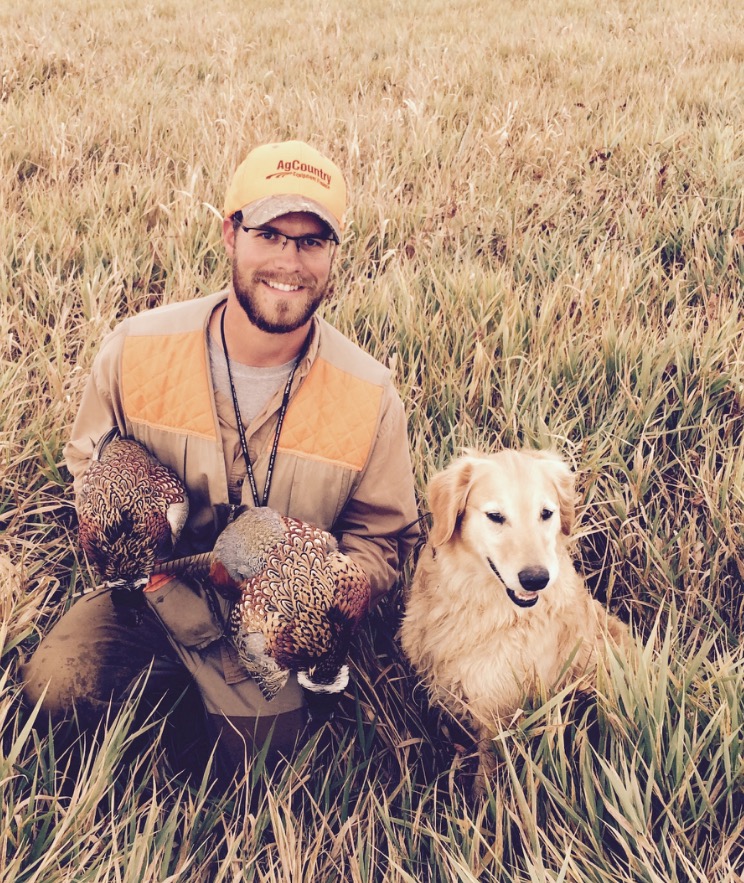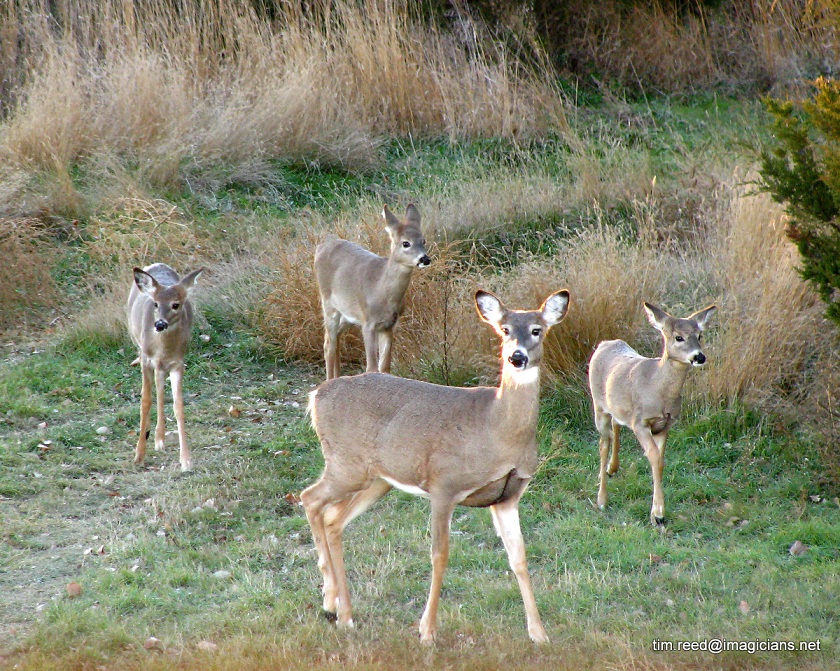 Wildlife Habitat
Wildlife Habitat
 Establishing winter protection at Daybreak Ranch is not only a priority, but a necessity for wildlife survival in South Dakota's potentially severe weather. We ensure wildlife has the necessary habitat to withstand our potentially harsh conditions.
Establishing winter protection at Daybreak Ranch is not only a priority, but a necessity for wildlife survival in South Dakota's potentially severe weather. We ensure wildlife has the necessary habitat to withstand our potentially harsh conditions.
Habitat is a priority on Daybreak Ranch's™ 8,000 private acres of native grassland, CRP, cropland, wetland sloughs, food plots and tree plantings. In the interest of managing wildlife populations, your group of sportsmen and sportswomen will hunt very diverse habitat each day. Daybreak Ranch is large enough that over the course of a 7 day hunt the only familiar places you'd recognize are the ranch houses and heated meeting area where we gather at the beginning and end of each hunt.
Daybreak Ranch's stewardship of land and wildlife is apparent with its strict management of natural resources. Each year, new habitat is established and expanded to add new challenges for returning hunters without having to travel great distances from the ranch house.
Establishing winter protection at Daybreak Ranch is not only a priority, but a necessity for wildlife survival in South Dakota's potentially severe weather. We ensure wildlife has the necessary habitat to withstand our potentially harsh conditions.
Want an unbiased, professional opinion? Read what Lawrence Pyne of The Upland Almanac published regarding habitat accomplishments, land stewardship and how it's paying off at Daybreak Ranch:
FIELDS OF PHEASANTS-
Improve the habitat and the birds will come
In the movie Field of Dreams, an Iowa farmer converts a cornfield into a ballpark on the premise that If you build it, they will come. You might say Jim Faulstich has taken the same approach on his family farm. Except instead of building bleachers and base paths to attract the ghosts of baseball greats, the South Dakota man planted shelterbelts, native grasses and food plots to bring back living, breathing wild pheasants.
If you plant it, pheasants will come. And in Faulstich s case, have they ever.
Driving down one of his farm roads prior to a morning s hunt is like being a kid in a candy store with a pocketful of quarters. Pheasants constantly dart across the road. Roosters cackle from every direction. The horizon is streaked with silhouettes of long-tailed birds flying to and from tracts of standing corn and golden grassland.
For pheasant hunters, it s a field of dreams come true. For Faulstich, a 50-something son of the prairie, it s the culmination of three decades of good land stewardship that has its roots in the bleak drought years of the mid-1970s.
It got so bad, we stopped planting corn, and in 1976 we had to sell our cows because we couldn t even cut any hay, he recalls. We used to think it was a waste if you didn t harvest everything out there, and we never managed for wildlife. If you saw just one pheasant back then, it was like a Christmas present.
When the dust settled, Faulstich reevaluated how he managed his land. For starters, he noted that compared to commercial shooting preserves which even during the lean years were able to produce a few wild birds in addition to sustaining the pheasants they released his property sorely lacked winter habitat and nesting cover.
 So he began planting trees. Lots of trees. Rows of fast-growing hardwoods flanked by thick, low-growing cedars and fruit-bearing shrubs. He created shelterbelts that provide pheasants with roosting, loafing and escape cover, and critical protection from winter winds and snows.
So he began planting trees. Lots of trees. Rows of fast-growing hardwoods flanked by thick, low-growing cedars and fruit-bearing shrubs. He created shelterbelts that provide pheasants with roosting, loafing and escape cover, and critical protection from winter winds and snows.
He also started planting switch grass, big bluestem, Indian grass and other native, warm-season grasses. He set aside areas free from mechanical and livestock disturbance, where once-scorned weeds could flourish. He restored excellent nesting cover and habitat for hens to rear their broods.
He resumed planting corn, some of which would not be harvested until the following spring, if at all. Near roosting and wintering cover, he strategically placed food plots, which not only help attract and hold pheasants, but also provide insurance against severe Dakota winters.
Woody shelterbelts, tall-grass nesting cover and food plots are a proven recipe for producing pheasants in the northern prairie. Faulstich, however, didn t stop there. He switched to year-round rotational grazing, ensuring that no one area would be grazed too hard or too long, with some areas grazed only once every three years. It allowed him to run fewer cows at a greater profit by saving him the time and expense of cutting hay in the summer and then hauling it back to his cattle in the winter while at the same time improving the habitat for pheasants, sharp-tailed grouse, prairie chickens and myriad other birds. He also switched to no-till farming of corn, wheat, sunflowers and other crops, which proved not only better for wildlife and water quality, but was also more economical.
 In short, he went from farmer and rancher to holistic land manager.
In short, he went from farmer and rancher to holistic land manager.
Our whole management scheme is now with wildlife in mind, says Faulstich, who with the help of his son-in-law has seen his farm grow to about 4,500 acres. We know if we do a good job grazing cows, it s good for the cows and it s also good for wildlife and water quality. And when we plant shelterbelts, we know we re also creating calf-weaning areas that are sheltered from spring storms. It s a win-win situation.
About 10 years ago, Faulstich s continued investments in habitat reached the point where it was time to bring in some partners in the form of paying hunters. Partners, he says, because much of the income he receives from hunting goes back into his land. Along with Burton Anderson, a neighbor who also oversees some excellent pheasant habitat, Faulstich now takes in small groups of hunters at $200 per day per gun, which includes accommodations in a newly remodeled farmhouse.
Even with his hunts, however, he has not forgotten lessons learned during the past droughts and blizzards. Hunts are always planned so that pheasants are pushed toward good cover, never away, and each area is gunned no more than once a week, so the birds are never driven out or over-hunted. He has also established sanctuaries with food and woody cover in the heart of each hunting area, so that when winter storms suddenly barrel down out of Canada, the birds will always know where to find protection.
Last November, my brother Jay and I had the chance to hunt with Faulstich and Anderson. For a pair of New Englanders accustomed to spending long hours improving the bird cover on our properties for only modest gains in ruffed grouse and woodcock, it was an eye-opener. While driving backroads across the heartland to Faulstich s farm 50 miles east of Pierre, I saw maybe a half dozen pheasants. By the end of my first day, I had seen several hundred, and that on only one small piece of his land.
Needless to say, the hunting was excellent. Even though at times our setters were overwhelmed by pheasant scent, and we elected to shoot only solidly pointed birds, daily limits of long-tailed roosters almost came too easily. Sharptails and chickens provided bonus opportunities.
Hollywood fantasies aside, we will never have the chance to watch Shoeless Joe Jackson and other past baseball greats play again. But thanks to conservation-minded farmers like Jim Faulstich, we can still enjoy wild pheasant hunting as good as anything their generation knew. His farm is a living example of what Aldo Leopold called the Land Ethic . Pheasants are the most obvious indicator, but everything from deer and badgers to meadowlarks and grasshopper sparrows are thriving under his stewardship.
I look at it this way, says Faulstich, who has received several awards for tree planting, grazing management, and soil and water conservation. Everybody has a calling. Ours is taking care of the land. Our mission is to leave it in better condition then when we received it.
May his kind prosper as well.
Note: For more information on upland bird and whitetail deer hunting with Jim Faulstich, contact Jim at (605) 852-2622, or faulstich@venturecomm.net, or 33795 186th Street, Highmore, SD 57345-5305.Our many thanks to The Upland Almanac and author, Lawrence Pyne, for allowing use of the above article found in the Summer, 2005 edition of The The Upland Almanac.
Daybreak Ranch is proud to be featured on Prairie Public Productions, America's Grasslands: A Threatened National Treasure. Prairie Public and Ducks Unlimited have teamed to produce this documentary about one of the most threatened biomes on the planet a biome that is in our own backyard. America s Grasslands: A Threatened National Treasure explores the uniqueness of this resource, the complicated reasons we re losing grassland, and the efforts of ranchers and conservationists to protect it.
Because no other landscape on the continent is more important to waterfowl, wildlife, and cattle producers than the native prairie in the Prairie Pothole Region of the Dakotas, the project producers traveled across both South Dakota and North Dakota to explore the uniqueness of this resource, the complicated reasons we re losing grassland, and the efforts of ranchers and conservationists to protect it. The program is funded by a grant from MDU Resources Foundation.


